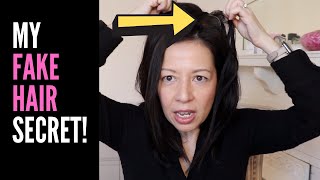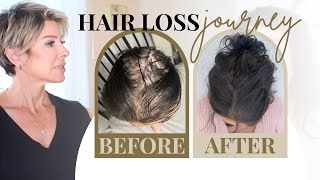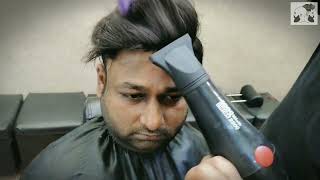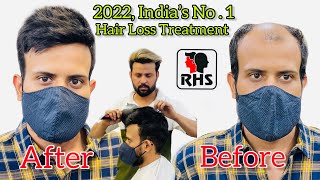How To Prevent Hair Loss on Temples with SMP
- Posted on 08 September, 2021
- Hot Topic
- By SNY Admin
Hair loss on both sides of the temples is a common condition when the body experiences physical or emotional stress changes. Like similar conditions, this phenomenon can be very stressful and take a massive toll on one’s confidence and body image. However, there is still hope. In the following article, you can find a basic understanding of the condition and suitable treatment.
Understanding The Hair Cycle
The average hair cycle lasts for 2-6 years. After that, new hair is regenerated and forms hair follicles, starting a new life cycle. The hair cycle has to go through 3 stages:
- Growth phase (anagen): 2-6 years
- Intermediate stage (catagen): 2-3 weeks
- Resting phase (telogen): 2-3 months
During the hair cycle, 85%-90% of the hair is in the growth phase, and the remaining 10-15% is in the intermediate and resting phase. This explains the fact that every day 50-100 hairs fall out. However, if hair loss per day is somewhat abnormal, it is a sign of androgenetic alopecia or a warning of health issues.
Temple Hair Loss And Its Symptoms
The first sign of temple hair loss is very noticeable: It is when you notice the phenomenon of hairline recedes that causes a “widow’s peak” – a little peek at the top of the forehead, or when your hair experiences continuous hair thinning after combing or washing your hair, or your hair falls out easily even with just a gentle stroke.
Hair loss on both sides of the temples is the first manifestation of M-style hair loss. This is when your hair begins to fall from the temple area and then spreads to the forehead and gradually pulls diffuse hair loss towards the top of the head, which can lead to baldness. Excessive hair loss at the temples can even occur when you gently stroke your hair or lie on your side while sleeping. This condition is more common in men, with only some women experiencing hair loss on the temple.
What Causes Temple Hair Loss?
Genetic Causes – A Prevalent Factor In Male Pattern Baldness
Many factors are causing patterned hair loss at the temples, but the most common cause is genetic due to family history. Hair loss on temples is often inherited inbreeding, which means if your parents suffered from baldness or hair thinning on the temples, they would more or less pass on the genetic code to you. Male pattern baldness is more common, but androgenetic alopecia does not exclude women. Hair loss in both men and women could be passed down from parents to children, which means you are more likely to go bald in late adolescence if your father, mother, or other relative experienced baldness. However, this factor can often be remedied.
In men, symmetrical hair fall at the temple region is an early manifestation of male pattern baldness. The androgenic alopecia often occurs after puberty, from 20 to 30 years old; with the indication of hair loss on both sides of the temples, new hair grows less and thinner. This phenomenon occurs when the male body secretes more androgens, which reduces the hair’s ability to synthesize protein, causing hair to fall out faster than usual. If not detected and treated in time, the hair will fall out and spread from the forehead to the top of the head, causing a receding hairline. Luckily, there are many ways to treat androgenic alopecia, discussed later in the article.
Although women do not suffer from female hair loss as common as men, women with hereditary hair also thinning soon face hair fall, thinning hair, weak fibers, etc.
Hormonal Changes
Endocrine disorders cause dihydrotestosterone (DHT) imbalances, a sex hormone that causes masculine characteristics such as body hair. The high concentration of DHT stimulates sebum to block the breathing of the hair follicles, causing the hair roots to weaken, fall off, and the hair growth cycle is affected. This condition is then called androgenetic alopecia.
Androgenetic alopecia, or more specifically the female pattern baldness on both sides of the temples, can also occur in people with significant hormonal imbalances in the body, such as postpartum women, women in perimenopause, menopause, or even men entering menopause.
Besides, pregnant women are also prone to female pattern hair loss. This is when the mother’s body experiences strong hormonal changes, affecting their physique and skin pigmentation. But, after giving birth, when the body’s hormones are back to normal, these problems also gradually decrease. They need to build a scientific lifestyle, have a balanced diet, then after giving birth, the hair loss at the temples will be improved.
Prolonged Stress And Unhealthy Lifestyle
The direct influence of the nerve system restricts the metabolism to help blood circulation and promote healthy hair growth. In addition, environmental factors, including improper hair washing, overusing hair products, overusing tight hairstyles, thyroid imbalance, etc., also cause pattern hair loss.
An unhealthy diet, alongside nutritional deficiencies, is also one of the common causes of temple hair loss. An unhealthy diet hinders the hair follicles from receiving adequate nutrients, thereby leads to thinning hair. In regards to traditional medicine, the temple is a special position of the body. Thus, temple hair loss is often a sign that the body lacks essential vitamins such as vitamin C, vitamin B12, biotin, etc.
Other Factors
Other factors causing hair loss include:
- Anxiety: People who experience anxiety or tiredness for a long period are also prone to patterned hair loss. This happens when your nerves are inhibited, leading to restricted blood circulation and a lack of nutrients to nourish the hair.
- Medical side effects: The use of therapeutic drugs such as medications for endocrine diseases, thyroid disease, blood clotting disorders, radiation therapy for cancer, etc., is also the cause of temple hair loss. The hair thinning will improve once the patient stops taking the drug (of course, after the disease is in remission).
- Risk factors: Improper hair care, overuse of chemicals, tight ponytails, smoking, regular intake of alcohol, having scalp fungus… are also contributing factors that cause temple hair loss.
- Other hair loss conditions: These medical conditions include scarring alopecia, traction alopecia, alopecia areata, etc.
Treatments For Temple Hair Loss?
Now that we have a thorough understanding of hair thinning at the temple let’s learn how to treat hair loss to regain your confidence and body image. Although early diagnosis can definitely accelerate the treatment, you can still find yourself a cure to temple alopecia without it.
Here are some of our best recommendations of appropriate treatment for those who are experiencing temple hair loss.
Scalp Micropigmentation
Permanent makeup technology has become quite popular in recent years. It is easy to spot people with eyebrow tattoos, eye tattoos, lip tattoos, and nowadays, even hair tattoos, called scalp micropigmentation. Scalp micropigmentation treatment is quite new on the market, but there are many benefits for those with thinning hair.
SMP procedure is a tattoo spray technique, which has been developed from tattooing on the human skin. With cutting-edge techniques and technology, doctors will clean the affected areas and shape a suitable hairline on the scalp, which is different for every individual. Doctors will then use microneedles to tattoo every single strand of hair meticulously to create a natural illusion of dense hair on a bald scalp. This technique can somewhat restore the lost hair, and you will have a set of “new hair” almost immediately. Although SMP for women is slightly more common, this technology is suitable for both gender at every age.
However, the treatment is quite costly if you are experiencing baldness. Thus this is the ablest option for those suffering from alopecia areata, bald patches, or small areas of balding temples.
Using Hair Growth Stimulants To Nourish Hair Follicles
Many people have chosen to use a hair growth stimulating drug with hair loss on both temples that heavily impact one’s appearance and confidence. These treatments mainly increase blood flow to nourish the hair follicles, providing some nutrients, which will have an almost immediate effect.
Hair growth stimulants are usually only used after you have consulted medical advice from your doctor. Oral or topical treatment will have certain effects to help nourish hair follicles and stimulate hair growth.
Common hair growth stimulants are Minoxidil (Rogaine®) and Spironolactone. However, the biggest downside of taking hair growth stimulants is that the balding areas will lose hair again when you stop taking the drug.
Natural Treatments
Olive oil
Olive oil is rich in essential ingredients for hair, such as vitamin E, minerals, and polyphenols, and it can penetrate your hair shaft. These ingredients help moisturize and stimulate hair follicles for faster hair growth and limit breakage. The polyphenols present in olive oil help restore and improve the damaged hair follicle.
Aloe Vera
Aloe vera cools and soothes the scalp. This herb also contains many vitamins such as A, B, C, and E, which are essential for hair growth and effectively reduce hair loss on both sides of the temples. Furthermore, the salicylic acid present in aloe vera leaves is a compound similar to aspirin. It has anti-inflammatory and antibacterial effects that help prevent scalp diseases such as folliculitis, effectively treat dandruff.
Green tea
Green tea contains EGCG, a powerful antioxidant that helps slow down the degeneration of hair follicles. Green tea also has antibacterial and antifungal properties and helps improve dandruff and scalp fungus.
Coconut Oil
Coconut oil is composed of fatty acids, vitamins E, K, minerals, antioxidants, etc. These are excellent nutrients for your hair, helping to reduce dryness and split ends. In addition, ingredients like lauric and capric acids are considered antibacterial and antifungal properties significant for the scalp and hair roots.
Potato Juice
Potato juice is rich in B vitamins, vitamin C, zinc, niacin, and iron, which help nourish the hair follicles, clean the scalp and unclog the hair follicle, which helps promote hair growth.
Autologous Hair Transplant Method
With this treatment, you will be able to use the healthy hair follicles at the back of your neck to transplant into the temples to regrow hair and stop the current hair fall.
In medical terms, a hair transplant is a procedure that “fills in” areas of thinning, balding hair with the biological or autologous follicles. Specifically, the doctor will use a specialized transplant tool to plug the follicle into the root of the scalp deeply. At this time, the follicles will grow and lengthen over time.




